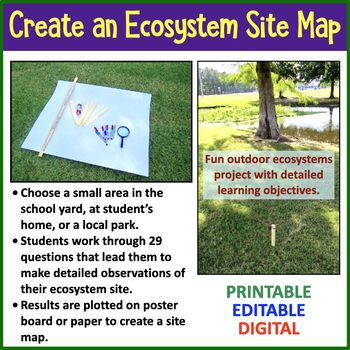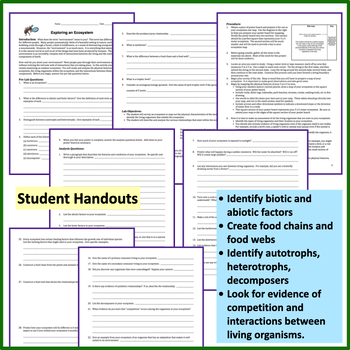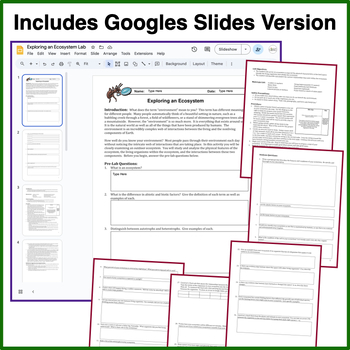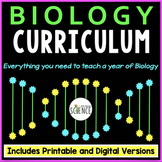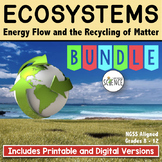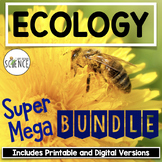Ecology Lab - Exploring an Ecosystem Project
- Zip
- Google Apps™

What educators are saying
Also included in
- This NO PREP, PRINTABLE, EDITABLE, AND DIGITAL Biology Curriculum contains everything you need for an entire year of Biology! For less than $3 a day, you can save your time, energy, and sanity. Each of the 20 Complete Units includes a teaching PowerPoint presentation, notes, labs, homework assignmenPrice $525.00Original Price $988.18Save $463.18
- This "Ecosystems Complete Unit Bundle" covers the flow of energy through ecosystems, the recycling of matter, food chains and food webs, energy pyramids, biogeochemical cycles, and more. See complete list of topics covered below.This unit bundle includes everything you need to teach a unit on ecosysPrice $39.99Original Price $52.72Save $12.73
- All of my ecology and environmental science resources (6 ecology unit bundles) are included in this one Super-Mega-Bundle! This mega-bundle includes all of the PowerPoints, notes, labs, task cards, homework assignments, review games, quizzes, activities, and unit tests that you need to teach a compPrice $178.00Original Price $252.64Save $74.64
Description
In this ecosystems project or activity, your students will be closely examining a small outdoor ecosystem. They will analyze the physical features of the ecosystem, the living organisms within the ecosystem, and the interactions between the biotic and abiotic components. Students will look for autotrophs, heterotrophs, predator-prey relationships, producers, consumers, decomposers, and much more. Students will create an ecosystems map to show their findings.
Choose to use the traditional printable version, or the paperless, digital Google Apps version.
This resource is perfect for distance learning and for students in 1:1 classrooms.
What is included in this resource?
- Printable and Editable Student lab handouts.
- Two versions of lab handouts: (a) Paper saving version (3-pages) where students write on their own paper, or (b) a 7-page handout that provides room for student work.
- Paperless Digital Version for Google Drive, Google Classroom, and/or Microsoft OneDrive
- Complete and detailed instructions.
- 8-Page Teacher Guide containing tips, tricks, and suggestions.
- Complete Answer Key.
Most of our students pay very little attention to their environment. They may frequent a public park or live on a lake or pond, but rarely do they notice the complex web of interactions that are taking place right before their eyes. For these reasons, I find this activity to be very worthwhile and worth the time it takes to complete. Furthermore, a group of 4 or 5 students will have to work very closely together to complete this project. The benefits of group work and the reinforcement of social skills are certainly life lessons that will be utilized long after the subject matter is forgotten.
I use this lab when teaching my unit on Ecosystems. It is the perfect activity to use with my PowerPoint and Notes on Ecosystems.
Purpose:
- The student will survey an ecosystem to map out the physical characteristics of the land and to identify the living organisms that inhabit the ecosystem.
- The student will describe and analyze the various relationships that exist within the ecosystem.
Materials List:
- One outdoor ecosystem
- Poster board or single sheet of white paper
- Colored markers
- 4 Stakes
- String
- Meter stick
- Magnifying glass (Hand Lens)
This lab project is very easy to set up and very easy to clean up. No fancy materials are required, and yet, I find this to be one of the best labs that I use with my biology students. Students will carry out a very detailed study of a 5m x 5m outdoor ecosystem. Students will identify the living organisms in their ecosystem and answer a detailed set of 29 questions designed to prompt students to make good observations. Students will make food chains and food webs using the organisms in their ecosystem. Students look for abiotic factors, biotic factors, evidence of competition, camouflage, predator/prey relationships, limiting factors, etc.
This lab is appropriate for students in grades 8 - 12. The experiment and collection of data is easily completed by students in these grades. The differentiation in ability levels comes in the analysis questions. For younger students, it may be necessary to omit some of the analysis questions. Student handouts are completely editable to meet your needs.
Related Products Include:
Food Chains and Food Webs Activity
Ecosystems Homework Bundle of 5 Assignments
Ecosystems - Energy Flow and the Recycling of Matter Quiz Bundle
Energy Flow and the Recycling of Matter Review Questions and Answers
Introduction to Ecology Complete Unit Bundle
Population Ecology Complete Unit Bundle
Community Ecology Complete Unit Bundle
For updates about sales and new products, please follow my store:


